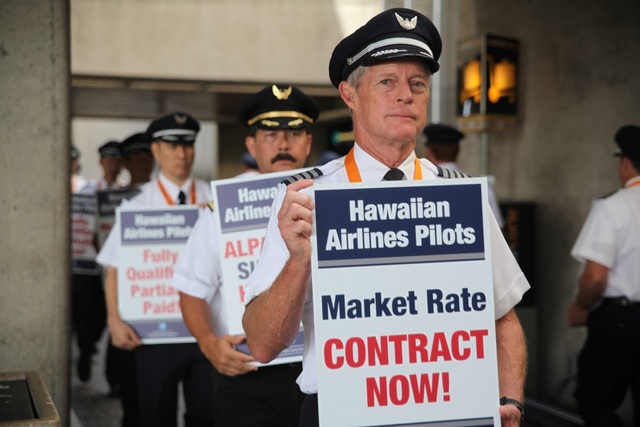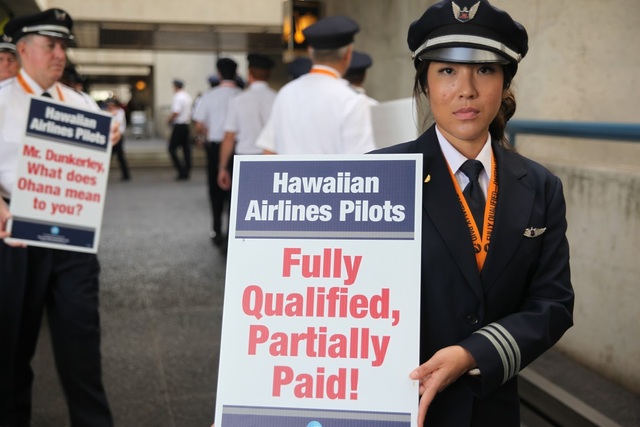KAILUA-KONA — For an island state that depends on one carrier to transport most of its people between islands, a walkout or a lockout at Hawaiian Airlines could leave residents and visitors with few options.
KAILUA-KONA — For an island state that depends on one carrier to transport most of its people between islands, a walkout or a lockout at Hawaiian Airlines could leave residents and visitors with few options.
If it comes down to a strike at Hawaiian Airlines, Bill Walter, vice president of the Hawaii Island Chamber of Commerce, said he hoped that pilots and management wouldn’t leverage vital interisland routes in the struggle to come to an agreement.
“There are other ways to do this,” Walter said. “They are island residents just like us; they don’t need to do that to our community.”
For instance, pilots could refuse to fly routes to the mainland, Walter said. That would impact tourism but wouldn’t have the same crippling effect on the daily course of business here.
On the mainland, people can work around a transportation strike by using other modes of travel. Here, loss of a major interisland carrier could leave travelers stranded without much recourse, Walter said.
Hawaiian Airlines, meanwhile, said it’s way too early to comment on possible effects of a strike as it’s still too far down the line.
But Island Air and Mokulele Airlines, with limited seats, wouldn’t be able to handle the capacity left by a pause in Hawaiian service, Walter said.
“It would have to be first come, first served, and important things would fall by the wayside,” Walter said.
Reason to worry?
Big Island residents needing to go to doctor appointments on Oahu, make business trips or attend to emergency family matters could all feel the sting of a shutdown.
More than a year into contract talks, Hawaiian pilots began informational picketing this week at Honolulu International Airport, and said those activities will continue going into summer months. The pilots voted by a 99 percent margin on May 17 to authorize a strike, but a number of steps lay ahead before that could happen.
Mediation between management and the pilots union will continue June 7-10 in Virginia. Before a strike could happen, the National Mediation Board would have to decide that additional mediation would be unproductive, and offer to arbitrate the dispute. If either side declined arbitration, there would be a 30-day cooling off period before a walkout by pilots or a lockout by management could commence.
“The pilots seek a market-rate contract with pay, benefits, and work rules equivalent to those earned by other pilots whose airlines fly to Hawaii, including Delta, United, Alaska, and American,” stated a Wednesday press release from the Air Line Pilots Association, the union which represents Hawaiian Airlines pilots. “Hawaiian’s total pilot compensation lags as much as 45 percent behind its leading competitors, even though the company is earning record profits and its stock price has skyrocketed over the last five years.”
But the sides don’t see eye to eye on this issue.
In an email to the newspaper, Hawaiian spokesman Alex DaSilva said ALPA is asking for a 52 percent increase in total compensation in the first year of its contract.
“The value of that increase is $74 million — for a workforce of roughly 600,” DaSilva said. “Our pilots are very well compensated. For example, a top-of-scale Hawaiian Airlines wide body captain, who has 12 years of seniority in the company, earns an average $242,000 annually for flying 700 hours a year. In addition to salary, they enjoy industry-leading benefits, such as medical coverage for life for retirees and their spouses. Hawaiian Airlines also contributes between 15 and 19.4 percent annually to the pilots’ 401 (k) plan.”
“We are committed to forging an agreement that acknowledges the value of our pilots’ work and is in line with our competitive position in the industry,” DaSilva said.
Outter islands affected?
A seasoned pilot with ties to the state’s commercial airline industry said it’s a mistake to focus only on the impacts to passengers and tourism.
“I can assure you that the pilots do not want to strike,” said the pilot, who did not want to be identified for this article. “They would like to reach a fair contract agreement with management … I submit that fair wages for pilots helps all workers get a better deal. And a better deal for workers anywhere is best for workers and owners everywhere, in the long run.”
Kirstin Kahaloa, executive director of the Kona-Kohala Chamber of Commerce, said a strike would crimp travel options and tourism, but that Island Air and Mokulele could provide some relief. Island Air, which flies between Oahu, Maui and Kauai, plans to offer five daily flights between Kona International Airport and Honolulu on June 14. The flights will be capable of transporting a total of 320 passengers daily.
Mokulele, based in Kailua-Kona, flies nine-passenger Cessnas on more than 120 daily flights around the state, with 23 daily flights departing from Kona.
“I would encourage people to use those airlines and if Mokulele and Island Air flights are over-capacity, I am sure this would be a welcomed opportunity for those airlines to increase flight options to accommodate the increase in demand,” Kahaloa said in an email. “We should continue to encourage affordable flights that promote island hopping as much as possible on all of interisland airlines.”
Attempts to get comment from Mokulele and Island Air by phone and email this week were unsuccessful.
DaSilva said that questions about potential impacts of a strike on Neighbor Island transport and how Hawaiian would handle the need for vital airlift between islands “are way too premature” with mediation ongoing.
A query was not responded to Friday asking the pilot’s union whether it would leverage interisland flights in negotiations or instead target routes less impactful to residents.
The state Department of Transportation did not comment on the possibility of a strike. In a related matter, DOT spokesman Tim Sakahara said the department continues to work with the Transportation Security Administration to reduce wait times at the state’s airports — an issue that’s irked travelers across the nation recently — going into the busy Memorial Day weekend.
“TSA has reported it has authorized overtime if needed over the Memorial Day weekend and additional checkpoints will be opened during peak periods,” Sakahara said. “We encourage people to allocate extra time to pass through security checkpoints, especially if they are traveling between 10 a.m. and 2 p.m.”




